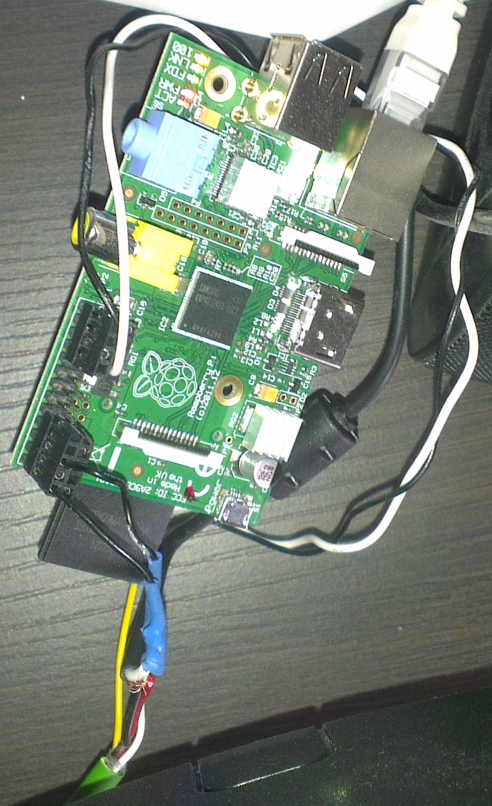software:frontends:ledpi
Inhaltsverzeichnis
LEDpi - Visualisierung per LED
Visualisierung des Stromverbrauchs / PV Einspeisung per farbiger LEDs
Hardware
- raspberry PI
- WS2801 LEDs (http://www.ebay.de/sch/?_nkw=WS2801%20RGB%20LED) entweder als Strip oder einzeln
- stärkeres 5V Netzteil (je nach Anzahl der LEDs 20-40 Watt)
- ein wenig Holz, Farbe und ein Alu Profil für die LEDs (https://www.google.de/search?q=led+streifen+alu+profil)
Verkabelung / Aufbau
Software
Prereqs
Damit die LEDs per serieller Schnittstelle angesteuert werden können, muss die Schnittstelle aktiviert werden. Dazu installiert man (sofern noch nicht geschehen) die python-dev und git Tools mit
apt-get install git python-dev
Dann holt man sich py-spidev und installiert es:
git clone git://github.com/doceme/py-spidev cd py-spidev sudo python setup.py install
Das eigentliche Script
Das PixelPi Script von https://github.com/scottjgibson/PixelPi wurde verschlankt und etwas umgebaut. So ist dieses Python Scripte entstanden. Das Scrpit übernimmt folgende Funktionen:
- Auslesen der aktuellen Werte aus der Volkszaehler Middleware
- Anzeigen der Leistung der einzelnen Kanäle in verschiedenen Farben (z.B. PV Leistung in Blau, davon eingespeister Strom in Grün, Verbrauch in Rot) Pro 500Watt wird eine LED voll erleuchtet (SCALE), die letzte dann in entsprechener Helligkeit
- die oberste LED blinkt grün um zu zeigen das das Script noch lebt
import httplib2 as http import json from pprint import pprint import argparse import csv import socket import time try: from urlparse import urlparse except ImportError: from urllib.parse import urlparse headers = { 'Accept': 'application/json', 'Content-Type': 'application/json; charset=UTF-8' } targetELW = urlparse('http://sqlserver/middleware.php/data/f2059450-bbbe-11e3-aabc-7bfab5f4b02e.json?from=now') targetHeizung = urlparse('http://sqlserver/middleware.php/data/26bce7c0-bbc2-11e3-b634-3334d2c934ae.json?from=now') targetHaus = urlparse('http://sqlserver/middleware.php/data/32e8d3d0-bbc2-11e3-8f42-eb76d7115f4b.json?from=now') targetPV = urlparse('http://sqlserver/middleware.php/data/4186f3e0-bbc2-11e3-a87a-8b10388c97ce.json?from=now') gamma = bytearray(256) spi_dev_name = '/dev/spidev0.0' PIXEL_SIZE = 3 SCALE = 500 BLACK = bytearray(b'\x00\x00\x00') BLUE = bytearray(b'\x00\x00\xff') CYAN = bytearray(b'\x00\xff\xff') FUCHSIA = bytearray(b'\xff\x00\xff') GREEN = bytearray(b'\x00\xff\x00') RED = bytearray(b'\xff\x00\x00') WHITE = bytearray(b'\xff\xff\xff') YELLOW = bytearray(b'\xff\xff\x00') # Apply Gamma Correction and RGB / GRB reordering # Optionally perform brightness adjustment def filter_pixel(input_pixel, brightness): output_pixel = bytearray(PIXEL_SIZE) input_pixel[0] = int(brightness * input_pixel[0]) input_pixel[1] = int(brightness * input_pixel[1]) input_pixel[2] = int(brightness * input_pixel[2]) output_pixel[0] = gamma[input_pixel[0]] output_pixel[1] = gamma[input_pixel[1]] output_pixel[2] = gamma[input_pixel[2]] return output_pixel def write_stream(pixels): spidev.write(pixels) return # MAIN spidev = file(spi_dev_name, "wb") for i in range(256): gamma[i] = int(pow(float(i) / 255.0, 2.5) * 255.0) Blinker = 0 pixel_output = bytearray(16 * PIXEL_SIZE + 3) method = 'GET' body = '' h = http.Http() while True: responseELW, contentELW = h.request(targetELW.geturl(),method,body,headers) ELW = json.loads(contentELW) ELWled = int(float(ELW["data"]["tuples"][0][1])) / SCALE responseHeizung, contentHeizung = h.request(targetHeizung.geturl(),method,body,headers) Heizung = json.loads(contentHeizung) Heizungled = int(float(Heizung["data"]["tuples"][0][1])) / SCALE responseHaus, contentHaus = h.request(targetHaus.geturl(),method,body,headers) Haus = json.loads(contentHaus) Haus["data"]["tuples"][0][1] = Haus["data"]["tuples"][0][1] - ELW["data"]["tuples"][0][1] Hausled = int(float(Haus["data"]["tuples"][0][1])) / SCALE responsePV, contentPV = h.request(targetPV.geturl(),method,body,headers) PV = json.loads(contentPV) PVled = int(float(PV["data"]["tuples"][0][1])) / SCALE led = 0 print "Haus: ", int(float(Haus["data"]["tuples"][0][1])), " Hausled: ",Hausled, "PV: ", int(float(PV["data"]["tuples"][0][1])) , " PVled ",PVled for led in range(19): pixel_output[led * PIXEL_SIZE:] = filter_pixel(BLACK, 1) if Hausled > led: pixel_output[(led * PIXEL_SIZE)+0] = '\xff' elif (Hausled == led) and (int(float(Haus["data"]["tuples"][0][1])) > 440): pixel_output[(led * PIXEL_SIZE)+0] = int(( float(Haus["data"]["tuples"][0][1]) % SCALE) / SCALE * 255) if -Hausled > led: pixel_output[(led * PIXEL_SIZE)+1] = '\xff' elif (-Hausled == led) and ( int(float(Haus["data"]["tuples"][0][1])) < -440): pixel_output[(led * PIXEL_SIZE)+1] = int(( float(Haus["data"]["tuples"][0][1]) % SCALE) / SCALE * 255) if (PVled > led) and (PVled > -Hausled) and (PVled > Hausled): pixel_output[(led * PIXEL_SIZE)+2] = '\xff' elif PVled == led: pixel_output[(led * PIXEL_SIZE)+2] = int(( float(PV["data"]["tuples"][0][1]) % SCALE) / SCALE * 255) if (led == 18): if (Blinker == 0): Blinker = 1 pixel_output[led * PIXEL_SIZE:] = filter_pixel( bytearray(b'\x00\x1C\x00'), 1) else: Blinker = 0 pixel_output[led * PIXEL_SIZE:] = filter_pixel(BLACK, 1) for c in pixel_output: print(c), print('\n') write_stream(pixel_output) spidev.flush() time.sleep(2)
software/frontends/ledpi.txt · Zuletzt geändert: von jau



